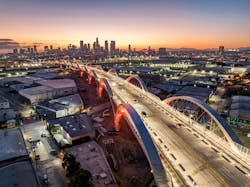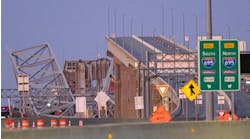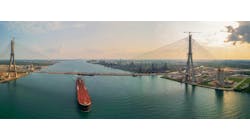In 2012, an HNTB-led design team won an international design competition held by the City of Los Angeles Bureau of Engineering to replace the iconic Sixth Street Viaduct, a beloved 1932 landmark that had served as the backdrop of movies, commercials, TV shows, music videos and countless personal stories.
The winning concept was a one-of-a-kind concrete network tied arch design that captured the imaginations of Angelenos, who had wanted a carbon copy of the original viaduct. Working with the Los Angeles Bureau of Engineering, under the leadership of City Engineer Gary Lee Moore and in partnership with the City’s Bureau of Contract Administration, the project team successfully delivered the largest, most complex bridge project in Los Angeles history, meeting each of the project’s challenging requirements with a series of engineering firsts.
Eighteen Y-shaped bents support the clean aesthetic and flow upward seamlessly into 10 pairs of sculptural arches, a design element intended to pay tribute to the original double steel arch viaduct.
The new viaduct’s arches extend outward at 9 degrees, opening skyward and providing perfectly framed cinematic shots of downtown LA at 300-foot intervals. The tallest pair of arches (60 feet) accent the LA River, where the original arches stood. The second tallest pair (40 feet) arc above US 101 Highway, serving as the gateway to the east.
All other arch pairs are 30 feet tall. At night, programmable LED accent lights installed below the deck and on the deck below the arch ribs illuminate the underside of the arches and Y-bents, giving the viaduct its name: Ribbon of Light.
Ensure greater public safety through seismic resilience. Designed to remain undamaged and operational after a seismic event with a 1,000-year return period, the viaduct sets a new precedent for seismic safety and is believed to be the world’s longest, seismically isolated concrete network tied arch bridge at 3,060 feet.
The viaduct also is the first structure in the U.S. to be designed with multistrand post-tensioning couplers in the prestressing system. Used to provide continuity of the 10 4.5-inch-diameter post-tensioning tendons placed in edge girders between frames, post-tensioned couplers were an efficient connection that made the post-tensioning continuous from one end of the bridge to the other. The solution achieved the efficient, clean aesthetic the design team envisioned and presented a case study for other U.S. bridges, where post-tensioning continuity between frames is needed.
“Show casing the benefits of the multistrand post-tensioning couplers will facilitate their use on future projects,” said Michael Jones, project manager at HNTB. “As an example, the Sixth Street project was selected as the Keynote Project Presentation at the 2021 Western Bridge Engineers Seminar.”
Impacting traffic was unavoidable, especially in Los Angeles, which is known for its congestion. However, Jones said the project’s team took that into consideration.
“Since portions of the new viaduct alignment overlapped the original viaduct alignment, particularly at the beginning and end of the viaduct, it was necessary to first demolish the existing structure prior to constructing the replacement,” he said. “However, to mitigate impacts to commuters to the extent possible, the project included improvements to local intersection. Prior to demolishing the original viaduct, an early construction task order within the project reconfigured local roads and intersections in the vicinity of the Sixth Street Viaduct to improve traffic flow in the absence of the viaduct.”
The new viaduct seamlessly connects the Arts District of Los Angeles with Boyle Heights, offering a viable east-west link that brings greater unity to one of the nation’s largest cities.
When residents said they wanted a multimodal structure, the HNTB-led team responded with a viaduct designed to increase transportation equity for the underserved community of Boyle Heights. Forty feet wider than its predecessor, the viaduct pulses with vehicle traffic, walkers, joggers and cyclists. R&B
Project: Sixth Street Viaduct Replacement Project
Location: Los Angeles, California
Owners: City of Los Angeles Bureau of Engineering
Designer: HNTB Corporation, architect of record and engineer of record, led the design team that included Michael Maltzan Architecture and Dissing + Weitling
Contractor: Skanska USA/Stacy and Witbeck, the construction manager/general contractor
Cost: $588 million
Length: 3,500 feet
Completion Date: July 10, 2022



